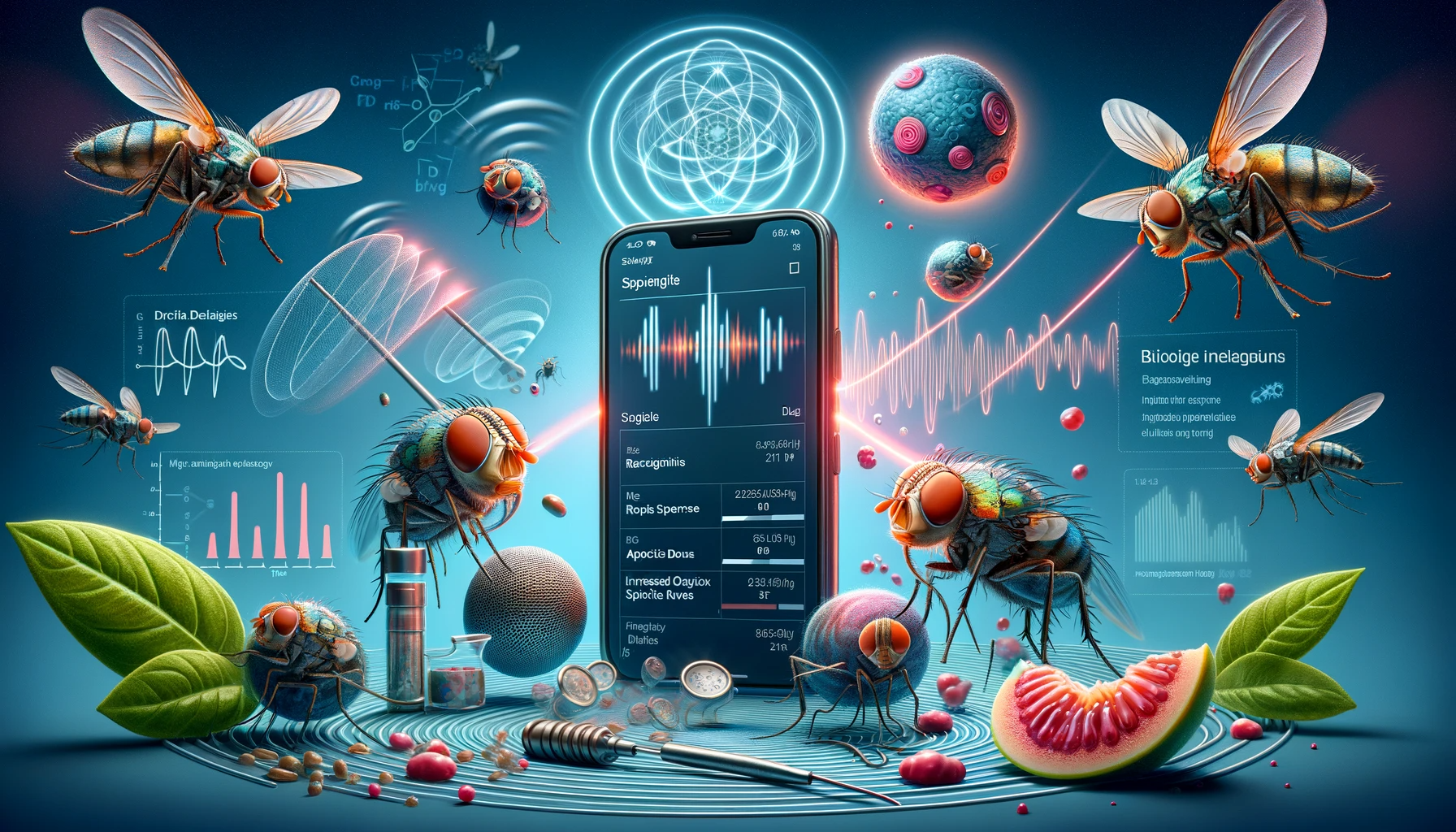A Potential Warning for Human Reproductive Health
In summary, this study aimed to investigate the effects of short-term mobile phone radiation on Drosophila melanogaster. The findings revealed that a 30-minute exposure to mobile phone radiation led to an immediate increase in ROS content and, later on, a notable increase in sporadic apoptotic cell death during early and middle oogenesis. Moreover, the exposure induced alterations in the transcriptional dynamics and gene-expression activities of early- and middle-stage follicles.
Gene-expression profiling analysis identified 168 differentially expressed genes (DEGs) that were classified into diverse biological processes. The results suggest that mobile phone radiation may act as a non-targeted and multifaceted cytotoxic agent that can simultaneously deregulate various cellular functions, potentially inducing systemic pathology in the ovary.
A number of DEGs were found to be involved in stress-related and death-related pathways, with some components of stress-associated pathways showing an upregulation in response to RF radiation. These findings, along with the observed oxidative and apoptotic cytotoxicity, indicate that mobile phone radiation may represent a hazardous stress factor with an intrinsic apoptotic capacity that can seriously harm Drosophila oogenesis.
Moreover, the study revealed that mobile phone radiation may also affect multiple cellular processes regulating fly oogenesis, such as vesicle-mediated transport, membrane organization, and endocytosis. Disruption of these processes could potentially result in impaired embryonic and post-embryonic fly development.
Lastly, the study highlighted the potential role of ROS-dependent transcription factors in the genome-wide reprogramming of ovarian gene expression upon Drosophila exposure to mobile phone radiation. Overall, the findings of this study provide valuable insights into the adverse effects of mobile phone radiation on Drosophila melanogaster and may have implications for human health. However, further studies are required to fully understand the underlying mechanisms and potential consequences of these effects.
This study focused on the effects of mobile phone radiation on Drosophila melanogaster, a fruit fly species. While the findings showed that exposure to mobile phone radiation led to increased oxidative stress, apoptosis, and alterations in gene expression that affected cellular processes regulating fly oogenesis, it is important to note that these effects were observed in fruit flies, not humans.
Further research, specifically focusing on human subjects or mammalian models, is necessary to determine the potential effects of mobile phone radiation on human reproduction and development, including the risk of birth defects, stillbirth, or other adverse outcomes.
If the same effects observed in Drosophila melanogaster were to occur in humans, potential parallels could include:
- Oxidative stress: An increase in reactive oxygen species (ROS) levels could lead to cellular damage in reproductive tissues, which may affect the quality of gametes (sperm and eggs) and impact fertility. Oxidative stress has been linked to various human health issues, including neurodegenerative diseases, inflammation, and aging.
- Apoptosis: An increase in apoptosis, or programmed cell death, in human reproductive tissues could lead to a reduction in the number of viable gametes, which may contribute to infertility or subfertility. This could result in a lower likelihood of successful conception or an increased risk of early pregnancy loss.
- Altered gene expression: Changes in gene expression affecting cellular processes regulating human oogenesis or spermatogenesis could lead to disruptions in gamete development, maturation, or function. This may result in impaired fertilization, embryo development, or pregnancy outcomes, potentially increasing the risk of birth defects or other developmental problems.
- Cellular processes: Disruptions in cellular processes such as vesicle-mediated transport, membrane organization, and endocytosis could impact the development of human gametes or embryos, potentially affecting fertility or increasing the risk of pregnancy complications or adverse birth outcomes.
It is important to emphasize that these potential parallels are speculative and based on the assumption that the same effects observed in fruit flies would occur in humans.
This study investigates the effects of mobile phone radiation on the wild-type Oregon R strain of Drosophila melanogaster (fruit fly). The flies were exposed to a commercial cell phone GSM-Talk 1800 MHz signal for 30 minutes. The Specific Absorption Rate (SAR) was calculated to be 0.15 W/kg, which is below the cell phone exposure limit of 1.6 W/kg for humans.
The methodology includes the following key aspects:
- Fly culture: Newly emerged female flies were collected and incubated in new vials with fresh medium at 24°C.
- Exposure conditions: Four days-old adult female flies were exposed to a cell phone GSM-Talk 1800 MHz signal for 30 minutes, while control flies were placed close to a switched-off mobile phone.
- ROS detection: Reactive oxygen species (ROS) levels in ovarian follicles were quantified using a fluorimetric assay and a ROS-species detector.
- Apoptotic assay: Acridine orange staining was used to detect apoptotic ovarian follicles.
- RNA extraction, amplification, and hybridization: Total RNA was isolated from ovarian follicles and used for gene expression analysis with GeneChip® 3′ IVT Plus Reagent kit.
- Microarray-data processing, normalization, and statistical analysis: R statistical-environment and Bioconductor package were used for microarray data analysis.
- Functional annotation and pathway analysis: Gene ontology analysis was performed using various bioinformatics resources, including DAVID, KEGG, PANTHER, and Ingenuity Pathway Analysis (IPA).
- Real-time quantitative PCR: An aliquot of each RNA sample was used for further validation of the microarray results using RT-qPCR.
The study’s results showed alterations in oxidative stress, apoptosis, and gene expression in fruit flies exposed to mobile phone radiation. Although the SAR value for the flies was lower than the human exposure limit, the study demonstrates the potential for mobile phone radiation to impact biological systems.
Mobile-phone radiation-induced perturbation of gene-expression profiling, redox equilibrium and sporadic-apoptosis control in the ovary of Drosophila melanogaster

Introduction:
Mobile phones have become an essential part of daily life, with their use increasing exponentially over the past few decades. While the convenience and connectivity they provide is undeniable, concerns have been raised about the potential health risks associated with exposure to mobile phone radiation. This essay will discuss a study that aimed to investigate the effects of short-term mobile phone radiation exposure on Drosophila melanogaster, a fruit fly species. The study’s findings provide valuable insights into the adverse effects of mobile phone radiation on biological systems and may have implications for human health.
Effects of Mobile Phone Radiation on Drosophila melanogaster:
The study exposed Drosophila melanogaster to mobile phone radiation for 30 minutes, leading to an immediate increase in reactive oxygen species (ROS) content and subsequent increases in sporadic apoptotic cell death during early and middle oogenesis. Moreover, the exposure induced alterations in the transcriptional dynamics and gene-expression activities of early- and middle-stage follicles.
Gene-expression profiling analysis identified 168 differentially expressed genes (DEGs) that were classified into diverse biological processes. The results suggest that mobile phone radiation may act as a non-targeted and multifaceted cytotoxic agent that can simultaneously deregulate various cellular functions, potentially inducing systemic pathology in the ovary.
Potential Implications for Human Health:
While the study focused on fruit flies, it is important to consider the potential implications for human health if similar effects were observed in human subjects. Oxidative stress, apoptosis, and altered gene expression affecting cellular processes regulating human oogenesis or spermatogenesis could lead to disruptions in gamete development, maturation, or function. This may result in impaired fertilization, embryo development, or pregnancy outcomes, potentially increasing the risk of birth defects or other developmental problems.
However, it is crucial to note that these potential parallels are speculative and based on the assumption that the same effects observed in fruit flies would occur in humans. Further research, specifically focusing on human subjects or mammalian models, is necessary to determine the potential effects of mobile phone radiation on human reproduction and development.
Conclusion:
The study provides valuable insights into the adverse effects of mobile phone radiation on Drosophila melanogaster. While the effects observed in fruit flies may not directly translate to humans, the study raises concerns about the potential impact of mobile phone radiation on biological systems. Further research is required to fully understand the underlying mechanisms and potential consequences of these effects on human health. As mobile phone usage continues to grow, it is crucial to investigate and address potential health risks associated with this technology.
FAQs
- What is mobile phone radiation?
Mobile phone radiation refers to the electromagnetic waves emitted by mobile phones when they transmit and receive signals. The radiation is in the form of non-ionizing radiofrequency (RF) energy, which is generally considered less harmful than ionizing radiation, such as X-rays.
- Is mobile phone radiation harmful to humans?
While some studies have shown potential adverse effects of mobile phone radiation on biological systems, the overall consensus among scientists is that there is not enough evidence to conclusively prove that mobile phone radiation is harmful to humans. However, more research is needed to fully understand the long-term effects of mobile phone radiation on human health.
- What are the potential effects of mobile phone radiation on Drosophila melanogaster?
A study has shown that exposure to mobile phone radiation can increase oxidative stress, apoptosis, and alter gene expression in Drosophila melanogaster, a fruit fly species. These effects may disrupt cellular processes regulating fly oogenesis, potentially impacting reproduction and development.
- Can the effects of mobile phone radiation on fruit flies be directly applied to humans?
While the study on fruit flies provides valuable insights into the potential effects of mobile phone radiation on biological systems, it is important to note that the effects observed in fruit flies may not directly translate to humans. Further research focusing on human subjects or mammalian models is necessary to determine the potential effects of mobile phone radiation on human reproduction and development.
- What is the Specific Absorption Rate (SAR) for mobile phones?
The Specific Absorption Rate (SAR) is a measure of the rate at which RF energy is absorbed by the human body when using a mobile phone. SAR limits for mobile phones vary by country, but in the United States, the Federal Communications Commission (FCC) has set a limit of 1.6 watts per kilogram (W/kg) averaged over one gram of tissue.
- What is reactive oxygen species (ROS)?
Reactive oxygen species (ROS) are unstable molecules containing oxygen that can react with other molecules in a cell, causing damage to cellular structures such as proteins, lipids, and DNA. An imbalance between the production and removal of ROS can lead to oxidative stress, which has been linked to various human health issues.
- What is apoptosis?
Apoptosis, also known as programmed cell death, is a natural process in which cells undergo self-destruction as part of normal development, growth, and maintenance of tissue homeostasis. An increase in apoptosis can lead to a reduction in the number of viable cells, potentially affecting the overall function of a tissue or organ.
- What is gene expression?
Gene expression is the process by which the information encoded in a gene is used to synthesize functional gene products, such as proteins or RNA molecules. Changes in gene expression can affect cellular processes, leading to alterations in cell function or behavior.
- What are differentially expressed genes (DEGs)?
Differentially expressed genes (DEGs) are genes whose expression levels change significantly between two or more experimental conditions or groups, such as control and treatment groups. DEGs can provide insights into the molecular mechanisms underlying biological responses to specific stimuli or conditions.
- How can I minimize my exposure to mobile phone radiation?
To reduce exposure to mobile phone radiation, you can use speakerphone or wired/wireless headsets, keep the phone away from your body when not in use, avoid long or repeated calls, and use a mobile phone with a lower SAR value. Additionally, you can limit the use of mobile phones in areas with weak signals, as phones emit more radiation when searching for a signal.








